A new product that has become a favorite of many gardeners - cucumbers “Siberian Garland F1”
The cucumber hybrid Siberian Garland F1 is the latest development of Ural breeders. This is a self-pollinating crop with abundant fruiting. It takes root well and bears fruit in all regions of Russia, is not afraid of temperature changes, and is resistant to major diseases of the pumpkin family.
Description of the hybrid
Siberian garland is an early ripening crop: 40–50 days pass from the moment of seed germination to the start of fruiting. The first harvest is harvested in mid-June and continues until the onset of cold weather. Cucumbers grow quickly, so they are picked every day so as not to slow down the formation of new ovaries.
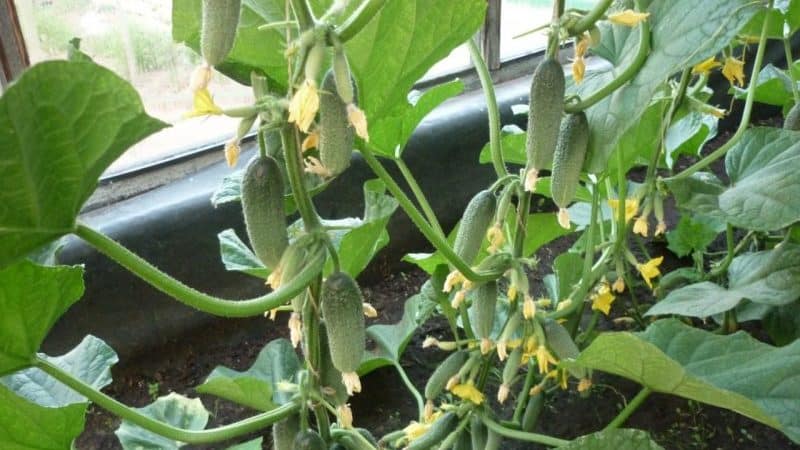
Distinctive features
The popularity of the hybrid is justified by its type of fruiting - bunched. Instead of one flower, bunches of 3–5 inflorescences are formed on the bushes. With proper care, the yield increases by 3–5 times compared to traditional indicators. According to the manufacturer, each bush grows up to 400 fruits, which is 20–22 kg of harvest.
Composition and properties
The fruits contain 15 kcal per 100 g.
The nutritional value:
- proteins - 0.92 g;
- fats - 0.11 g;
- carbohydrates - 2.6 g;
- fiber - 0.6 g.
Cucumbers contain vitamins B, C, E, PP. The pulp consists of 90% structured water, which removes harmful substances from the body.
Useful properties of vegetables:
- improvement of blood composition;
- dissolution of sand in the kidneys, which prevents the formation of stones;
- getting rid of cholesterol plaques;
- removal of salts from the body.
Due to their low calorie content, cucumbers are added to the diet.
Characteristics
The hybrid Siberian Garland is parthenocarpic, that is, it does not require pollination by insects.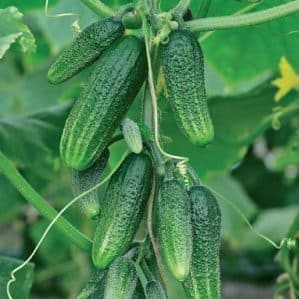
The bushes are powerful with a well-developed root system that feeds a large number of fruits. Therefore, the fit is not tight.
The stem is powerful, heavily leafy, thickness - 1 cm, height - 2 m. The distance between the nodes is up to 8 cm. The number of ovaries in the internodes exceeds several dozen. Bushes are formed by removing side shoots.
The cucumbers themselves are small, from 5 to 8 cm, weighing 25–50 g. The color varies from light green to rich green with light stripes. The skin has small tubercles and soft light spines. The fruits do not overgrow, and voids do not form in them when harvesting is delayed. The seeds are small and do not ripen.
The pulp is juicy and sweet, without bitterness, with a characteristic crunch and pleasant aroma.
How to grow your own
Siberian garland is cultivated by seeds, seedlings, in greenhouse conditions or in open ground. The hybrid tolerates light partial shade well.
Planting seeds and seedlings
The seeds are pre-treated. First, full-fledged specimens are selected by placing the material in a solution of table salt for 30 minutes. They only take those that have sunk to the bottom. To protect against diseases, seeds are disinfected in a solution of potassium permanganate, agave juice or Fitosporin-M.
To increase germination, planting material is heated in the oven at +50...+55°C for 2 hours. Some farmers harden the grains for 2 days in the refrigerator, in a damp cloth.
Reference! Hardening increases the resistance of future seedlings to temperature changes and diseases.
Seeds are planted for seedlings at the end of March - beginning of April in peat pots.Such a container will allow you to plant the sprouts in the ground without picking; the roots will grow through the peat layer.
The pots are filled with a nutrient mixture for seedlings and disinfected with a weak solution of potassium permanganate. The seeds are planted in the soil to a depth of 1.5 cm. The containers are placed in a warm, illuminated place and covered with film. Water with warm water every 3-4 days. After about a week, the first shoots will appear, then the film is gradually removed: first for 7–10 minutes, after the formation of the first leaf - for good.
Direct sowing into the ground is carried out when the soil warms up to +15°C at a depth of 10–15 cm. This usually happens in May. Before planting, the seeds are germinated in warm, damp gauze.
The distance between grains is 7-8 cm, between rows is 18–20 cm, planting depth is 4-5 cm. The beds are covered with film or protective material until shoots emerge.
Step-by-step cultivation
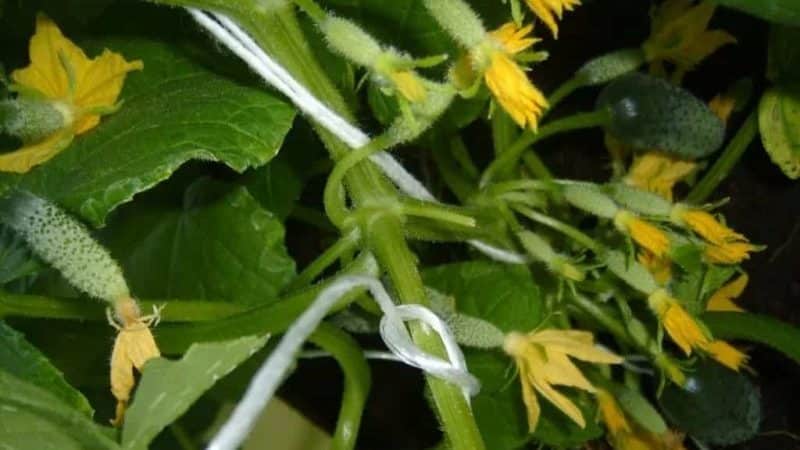
When 2 pairs of true leaves appear on the sprouts and the root system is sufficiently formed, the seedlings are planted in prepared beds. In a greenhouse this is done in early May, in open ground - in late May - early June.
No more than 6 plants are planted per 1 m2. The distance between the rows is 45–50 cm, between the bushes - 50–55 cm. A little wood ash and humus is poured into shallow holes (10–15 cm). The plant is placed on top along with a peat pot. If the seedlings were grown in ordinary containers, they are carefully pulled out along with a lump of earth and placed in the holes. The plants are sprinkled with soil and watered abundantly with warm water. In the first days, shade from the sun.
Attention! Cucumbers are planted in the soil after a layer of soil 20 cm deep has warmed up to at least +18°C.
Watering cucumbers in the morning or evening, until flowering - 2 times a week, then - once every 2 days.The frequency of wetting depends on weather conditions. Do not allow the soil to dry out.
After watering, the soil is loosened. To prevent the beds from drying out, they are mulched.
Much attention is paid to fertilizing. During growth, seedlings are fertilized every 14 days:
- 2 weeks after picking, organic matter is used: a solution of bird droppings (1:20) or cow manure (1:10). Alternate with mineral fertilizers: 20 g of superphosphate and 10 g of urea per 10 liters of water.
- At the beginning of flowering, feed with an infusion of herbs (1:8), a solution of wood ash (1 tbsp per 10 liters of water) and a solution of 10 g of urea, 10 g of potassium sulfate, 20 g of superphosphate, diluted in 10 liters of water.
- Subsequently, the concentration of nutrients is increased by 1.5 times.
Important! The hybrid Siberian garland, due to its abundant fruiting, requires additional nutrients for a high growth rate of vegetables.
Fertilizers are supplemented with foliar treatments. The bushes are sprayed every 14 days in the morning or evening with products in which the concentration is 2 times less than for root dressings.
Features of cultivation and possible difficulties
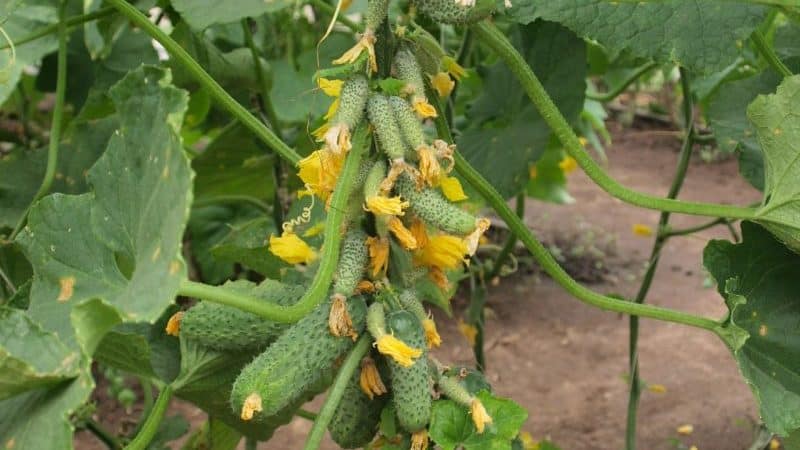
Hybrid bushes form into one stem. For this:
- install a trellis to which the growing branch is attached;
- remove shoots, ovaries and leaves in the first 4 internodes;
- as the branches grow, pinch off the side shoots, except for 1 leaf and all ovaries;
- when the branch stretches above the trellis, it is wrapped around a horizontal upper fastening (rope, twine), and the top of the branch is pinched.
Excess leaves are removed to reduce the load on the branches.
Due to the abundance of fruits, the Siberian garland does not tolerate long breaks between watering And fertilizing. If the bush is formed incorrectly, a significant part of the harvest is lost.
Diseases and pests
The hybrid is resistant to powdery mildew, cucumber mosaic, and brown spot.
With improper agricultural practices, seedlings are susceptible to root rot. At the first signs of damage, the soil at the base of the stem is slightly loosened and watered with an infusion of wood ash or chalk powder with the addition of copper sulfate (1 tbsp. ash or chalk, 1 tbsp. copper sulfate per bucket of water).
The drug “HOM” is used against the disease (dilute 200 g per 10 liters of water). “Previkur” has proven itself well, protecting plants from fungal infections. The treatment is repeated after 2 weeks.
Gray rot may appear on shoots and fruits. To combat it, the branches are treated with a composition of 10 parts of wood ash and 1 part of copper sulfate. Spraying and watering with a mixture of 2 g of copper sulfate, 1 g of zinc sulfate, 5 g of urea, diluted in 10 liters of water is effective.
To prevent the formation of rot, treat the soil with Trichodermin once a week.
Against aphids They use an infusion of plants with a strong odor: garlic, onions, tobacco, hot pepper. To enhance the effect, liquid soap is added to the infusion. The bushes are sprayed once every 5 days until the pest is completely destroyed.
In case of severe damage, insecticides are used: “Aktaru”, “Iskra Bio”, “Fitoverm”.
When spider mite Fitoverm, Omite, Akarin, Neoron are used. 4-5 treatments will be needed, with the drugs alternated, since ticks quickly get used to one drug.
Cucumbers are often affected whiteflies, which settle on the back of the leaves. As a result, the green mass falls off. Minor lesions are wiped with soapy water and washed off with water. The bushes are sprayed with a mixture of garlic and onions. Traps coated with sticky honey or jam help.The drugs used are “Budon”, “Citcor”, “Iskra Bio”.
When attacked by a germ fly, treatment is carried out with Kemifos and Iskra Bio.
If the roots are affected by root-knot nematode, the bushes are watered with a 2% Carbation solution.
Harvesting and application
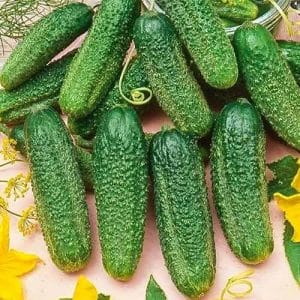
Harvesting begins in the second half of June. The fruits are removed from the bushes daily as they ripen. The best harvest time is morning and evening: at this time, cucumbers are at their most elastic. They are cut with garden shears so as not to pull or pull the branches.
When stored in the refrigerator, vegetables do not spoil for up to 7-9 days, in the cellar at a temperature of +8...+12°C and high humidity - up to 2 weeks.
Cucumbers of this hybrid are suitable for pickling and pickling. Thanks to their small size, they look impressive when serving food on the table.
Advantages and disadvantages
Advantages of culture:
- stable adaptation to any weather conditions (the hybrid is grown even in the northern regions of Russia);
- self-pollination;
- short period of fruit ripening;
- high productivity;
- long fruiting period (in the southern regions until the end of autumn);
- excellent taste of vegetables;
- immunity to major diseases of cucumbers.
Disadvantages of a hybrid:
- the need to collect fruits daily so as not to slow down the development of new ones;
- relatively high price of seed material: a bag of 5 seeds costs from 78 to 125 rubles;
- impossibility of using seeds for the next season.
Reviews from vegetable growers
Many farmers note the high productivity of the crop, juicy tasty vegetable pulp and long-term fruiting.
Lyudmila, Volgograd: “Last season, I was interested in a new cucumber product - Siberian Garland. I decided to try it. The result pleased me, especially with its quantity.The whole family liked the little green cucumbers, like in the photo. The only difficulty is to grow a branch without side shoots.”
Sergey, Novosibirsk: “I was pleasantly surprised by the Siberian Garland hybrid. During the season, I harvested 50 kg of tasty vegetables from each plant (I have 4 of them). Enough for all the relatives. I liked picking cucumbers all summer and fall. It’s a shame that you have to buy seeds every year.”
Natalya, Omsk: “I’ve been growing Siberian garland for two years now. The hybrid is early ripening, the cucumbers are sweet, without bitterness or voids. Every day before work I collected several pieces. I really like marinating them.”
Conclusion
Cucumbers Siberian Garland F1 is a new bunch-type hybrid that does not require pollination. It is unpretentious in care, is not afraid of temperature changes, is resistant to powdery mildew, cucumber mosaic and brown spot, and produces a bountiful harvest (up to 22 kg per bush). The crop bears fruit for a long time, so cucumbers delight farmers from mid-summer to late autumn.